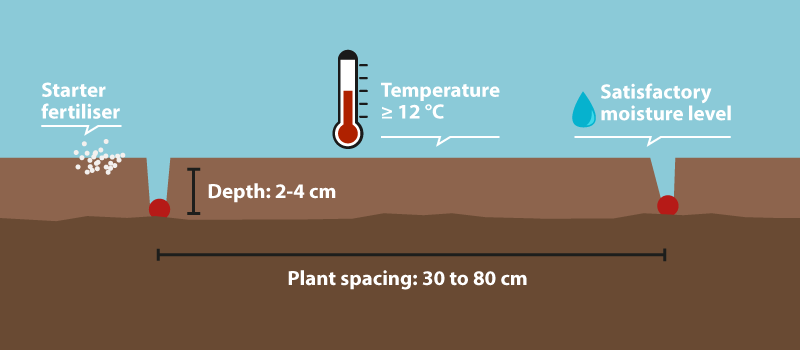Favourable Conditions for Good Sorghum Crop Establishment

Spring is already here and it is time to talk about the best practices of sorghum planting. Hybrid choice, planting density/depth/date, soil temperature, and plant spacing are all important factors that Aude Carrera, regional agronomist with the ARVALIS Institute, has been kind to share with us, to help producers ensure good crop establishment conditions for their sorghum.
 Choosing the Proper Hybrid and the Proper Plot
Choosing the Proper Hybrid and the Proper Plot
To ensure a good production cycle, the earliness of the hybrids we choose should match the specific climate in one’s region, Aude Carrera explains. For instance, if the climate is not very generous, one should choose a hybrid with sufficient earliness, that can be harvested at maturity in good conditions.
Added to hybrid choice is soil type. Shallow soils should be avoided if irrigation is not an option. To ensure optimum sorghum conditions, the plot’s soil should present satisfactory moisture levels (which favour emergence) and its temperature should not be less than 12°C.
Planting: a Key Stage, for Sorghum
Aude Carrera reminds us that the quality of the crop’s emergence and establishment will influence ensuing yields: Sorghum is planted relatively densely, but the establishment stage is crucial, because we are talking about a tiny grain, which needs the proper conditions in order to germinate. Seeds should therefore be planted neither too close to the soil surface, nor too deeply: the planting depth should be comprised somewhere between 2 and 4 centimetres, with a fairly fine seedbed favouring good seed-to-soil contact.
Determining Planting Density
Sorghum planting density depends on three main parameters: earliness, soil type, and loss rate upon emergence.
- Hybrid Earliness
The earlier the variety, the lower the LAI and the smaller the number of grains per panicle. Planting density should therefore be greater with less early, later varieties. - Soil Type
Planting density also depends on soil moisture: thick planting will favour biomass development, which in turn can deplete available water capacity. One must therefore consider AWC carefully (or one’s possibilities to irrigate) when planting. - Loss Rate upon Emergence
Sorghum has a relatively low germination capacity, so producers should expect a 20-percent loss rate upon crop emergence.

What about Plant Spacing?
To prevent competition, plants should be well-spaced. In sorghum crops, spaces between plants vary between 30 and 80 centimetres.
If possible – especially when planting at high densities – one should favour smaller inter-plant spacing, of ideally no more than 60 centimetres, Aude Carrera reminds us.
We should of course also consider the drilling equipment that we have. While single-seed drills should be one’s first choice for optimum yield, regular grain drills can also be used, although their planting regularity is not as good.
A Little Boost in the Crop’s Early Stage
Starter fertilisers are a real plus in providing better early vigour and even emergence. “Applied upon planting, the fertiliser contains nourishing elements such as phosphorous and nitrogen, which favour early rooting and crop establishment, which in turn produce higher yields”, Aude Carrera adds.
Remain Alert to Pests
Sorghum is less prone to bird damage; however, it can be vulnerable to soil pest attacks. On plots with wireworm risks, producers should protect their crops using wireworm-specific products.
Continue ?
INRAE Research on Sorghum Grain Digestibility

Multiuse













